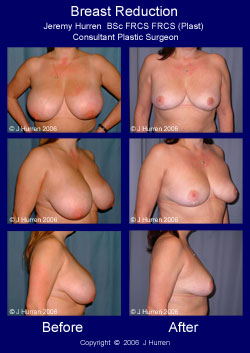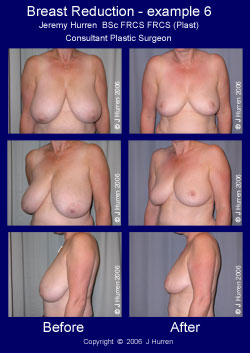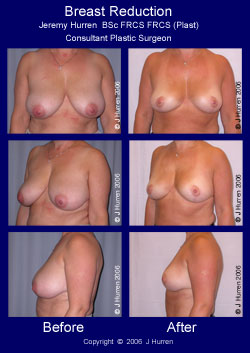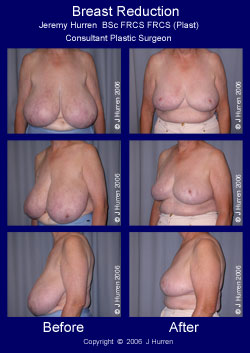BREAST REDUCTION
(REDUCTION MAMMAPLASTY)
What is a breast reduction?
A breast reduction is a surgical procedure to reduce the size of the breast.
The breasts are usually reshaped and lifted at the same time.
(Mastopexy or breast lift is a similar but smaller operation to lift and reshape rather than reduce the breast size.)
Different techniques
Is it right for me?
Breast reduction is individualised to your requirements. Typically 500 1000gms (1-2lbs) are removed from each breast. However, if necessary, much more can be removed.
Breast reduction is frequently very helpful in relieving symptoms such as back ache, in cutting bra straps and rashes under the breasts. Many women improve their posture following surgery.
Smaller reductions with an emphasis on lifting and reshaping are usually regarded as a mastopexy (breast lift).
A one sided reduction may help with breast asymmetry.
A breast reduction may be a useful procedure to remove a breast cancer.
Medical considerations
Illnesses Discuss at consultation
Obesity Lose weight before breast reduction surgery if you are over weight
Medication Discuss all medication at your consultation
Oral contraceptive pill the pill doubles the risk of clots in the leg veins.
Discuss discontinuing it 4-6 weeks prior to the operation with your surgeon.
Avoid aspirin and non steroidal anti-inflammatory drugs e.g. ibuprofen for 10 days before surgery
Smoking Stop smoking 4-6 weeks before surgery to reduce complications
The operation
Anaesthetic General Anaesthetic
Duration 3 to 4 hours varies with type of operation and size of breasts
Incision / scar Depends on the technique used
1) Standard reduction scar is anchor shaped (The 'Wise' pattern)
2) Vertical scar reduction (Lejour type) - circle around nipple and strait line from the nipple
3) Circumareolar technique scar just round nipple not usually used for reductions
Your recovery?
Hospital stay 2 nights following surgery
Stitches under the skin and absorbable (dissolving). Do not require removal
Drains Usually removed next day. ( Drains are not always required).
Dressings Sticky tape over wounds
Driving Usually start 10 14 days following surgery
Return to work 10 14 days light work i.e. office type
Gym After 4 weeks gentle lower body / 6-8 weeks return to normal activity
Swimming When fully healed. Typically 4-6 weeks after surgery.
What are the risks?
All operations carry risks. Most people are pleased with the results of their surgery and do not suffer significant complications. Serious, including life threatening complications are very rare. Complications can result in the need for further surgery.
General complications are those that may occur with any operation and include:
Complications of the anaesthetic.
Complications of the surgery including bleeding, infection, wound breakdown, slow healing, poor scarring (red, thick, lumpy or stretched scars. Keloid scars).
Reduced mobility following surgery increases the risk of clots in the legs (deep vein thrombosis). Clots can move the lungs (pulmonary embolus) where a large clot can be fatal).
Special considerations for breast reduction surgery:
See section below
Special considerations for Breast Reductions Surgery
Breast Feeding Usually not possible after breast reduction surgery
Nipple sensation Usually feeling in the nipple is lost.
It may return with time but you should not assume that it will
Nipple loss The nipple is moved during the operation (usually not taken completely off). There is a small risk to the nipple. This can result in scarring or loss of colour. Very rarely the nipple may die
Breast shape The breasts will be smaller and higher following surgery.
Your breasts will not normally enlarge again unless you put on weight.
Asymmetry There may be differences in size and shape of the breasts following surgery. (This is common for women who have not had surgery!)
Fat necrosis Hard lumps of fat in the breast sometimes for following surgery.
These may cause anxiety but are not serious.
Sometimes removal is recommended
Bottoming out Over time the breast may droop this may result in the nipples appearing too high
Complications are more likely if you are overweight. It is desirable to achieve your ideal weight prior to surgery so as to minimise risks.
Smoking increases the risk of complications and stopping smoking for 4-6 weeks before surgery will help to minimise the risk.
My new look and expectations
Your breast will be smaller. They will be higher on your chest and have an improved shape. Breast reduction is frequently helpful with reducing back pain, improving posture and reducing self consciousness, although these benefits can not be guaranteed. Most people are very pleased with the results of breast reduction surgery.



